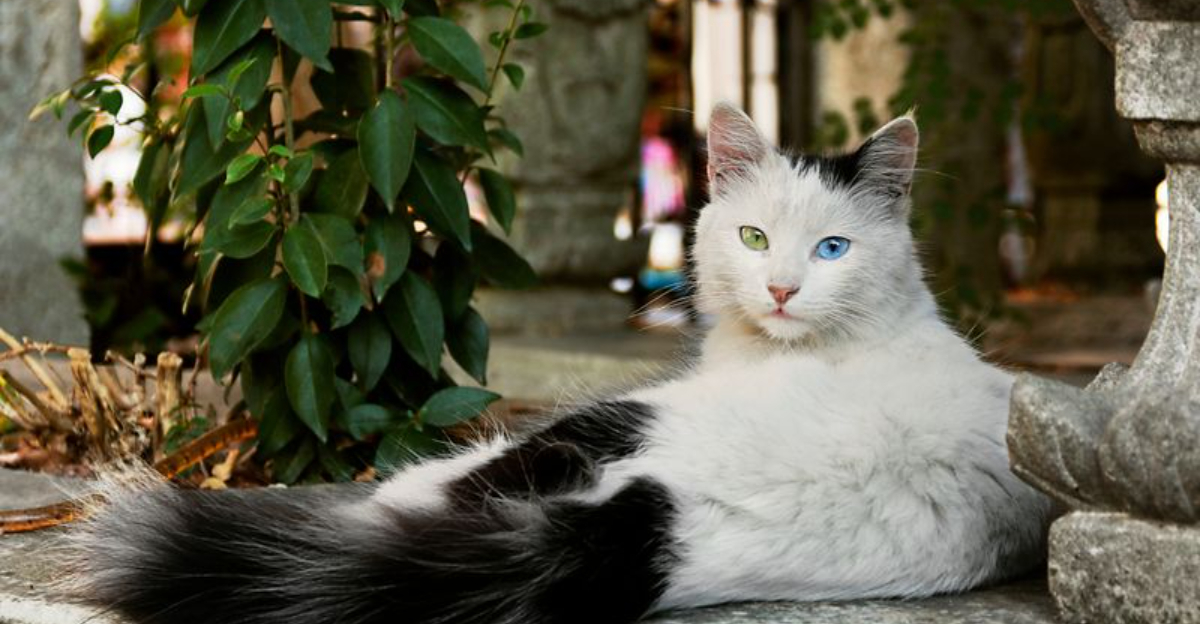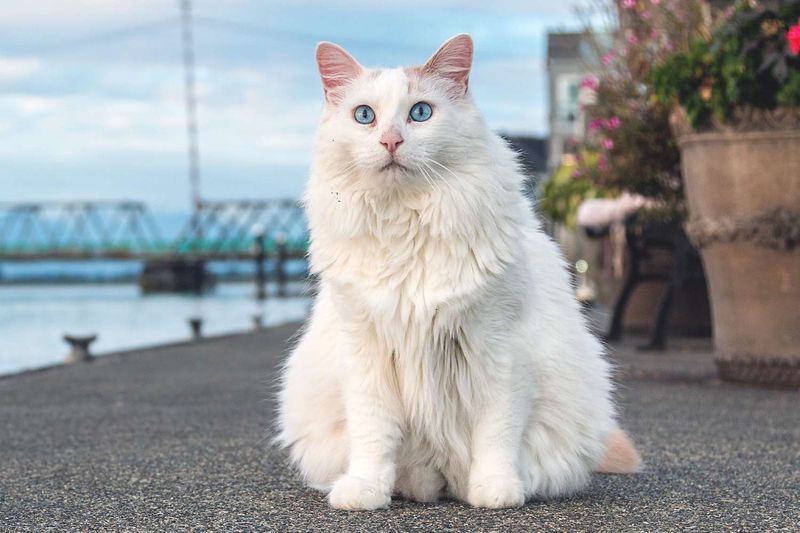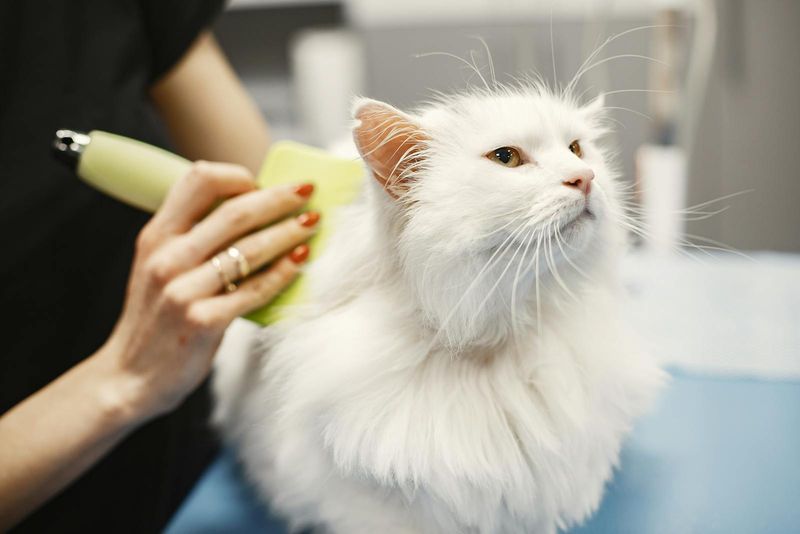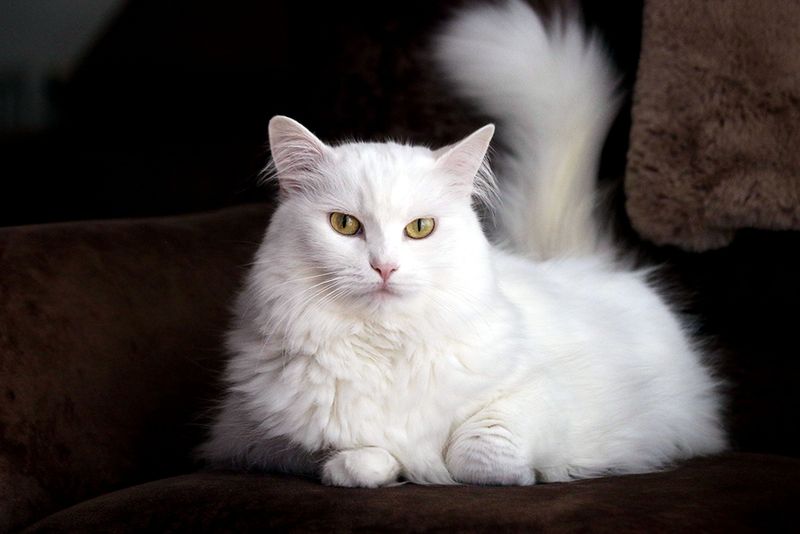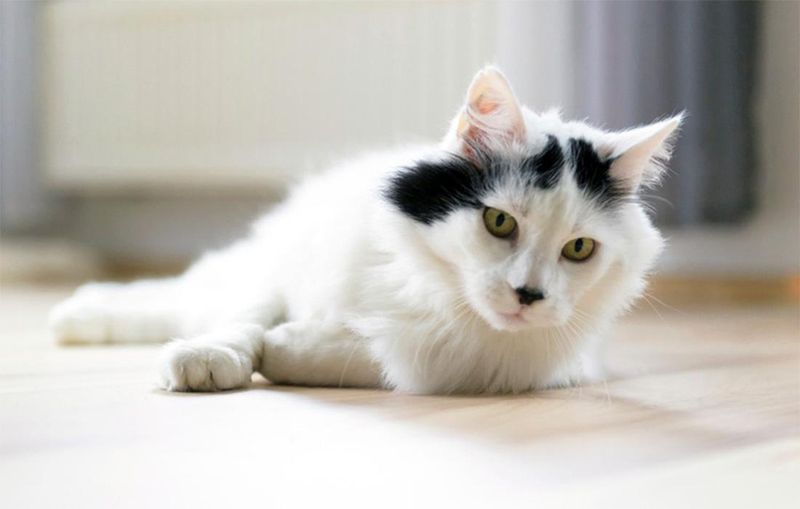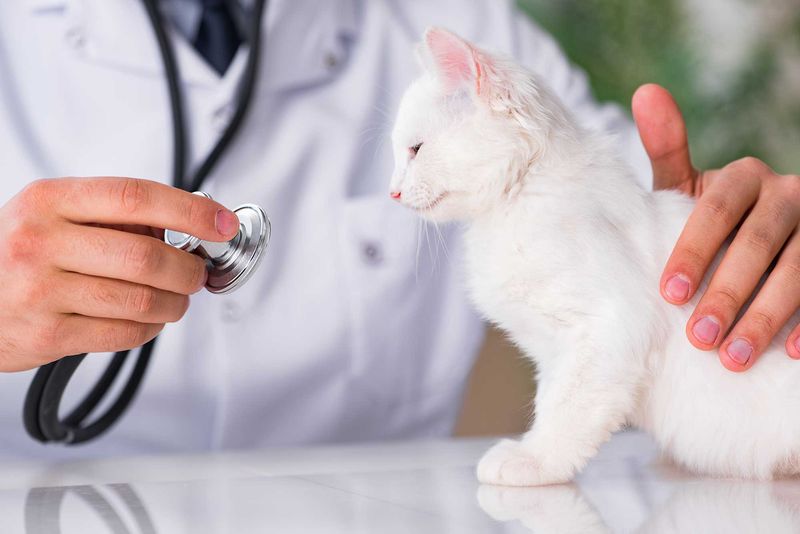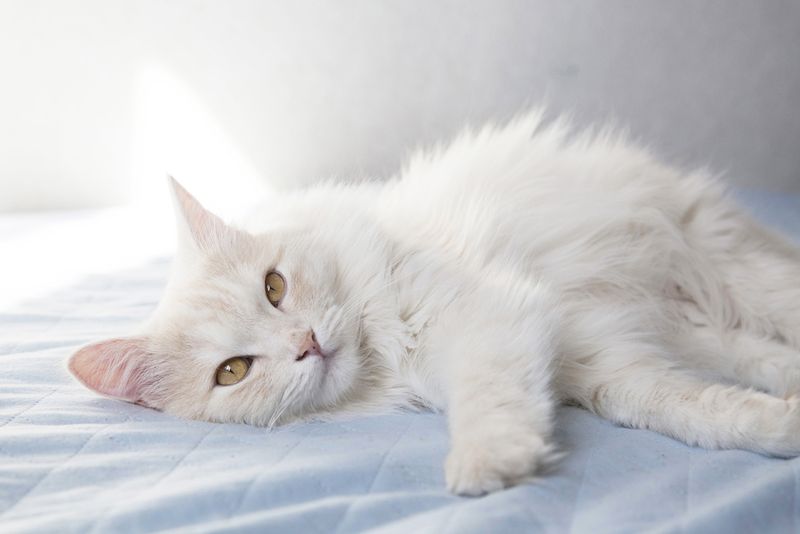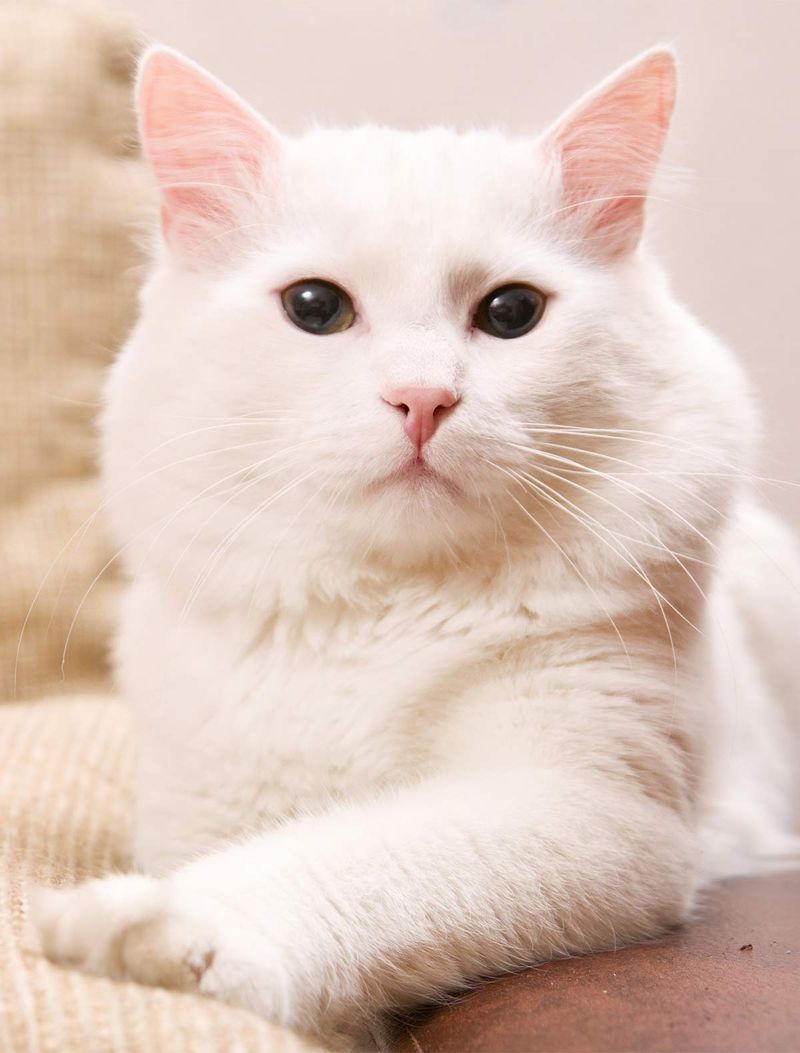📖 Table of Content:
- 1. Vocal Demands That Border on Constant Conversation
- 2. Astonishing Intelligence That Leads to Mischief
- 3. Excessive Energy Levels That Never Seem to Fade
- 4. Water Fascination That Defies Typical Cat Behavior
- 5. Surprising Seasonal Coat Changes That Transform Your Cat
- 6. Territorial Nature That Challenges Multi-Pet Households
- 7. Sensitivity to Environmental Changes That Causes Stress
- 8. Health Concerns That Require Specialized Veterinary Knowledge
- 9. Demanding Social Needs That Limit Your Independence
- 10. Surprising Stubbornness Behind That Elegant Exterior
The Turkish Angora is hard to ignore, with its flowing white coat and dazzling blue or odd-colored eyes. This breed combines elegance with a light, athletic build that moves with surprising agility. Its regal looks often make it a favorite among cat enthusiasts seeking a visually striking companion.
Beneath that graceful exterior lies a curious and spirited personality. Turkish Angoras are known for their intelligence, independence, and occasional stubborn streak. They often crave interaction and mental stimulation, making them more demanding than they might appear at first glance.
While their beauty draws people in, living with a Turkish Angora brings unexpected challenges. Their energy, vocal nature, and need for engagement can surprise first-time owners. Taking time to understand the breed’s temperament and needs is key to building a lasting and happy bond.
1. Vocal Demands That Border on Constant Conversation
Got plans for peaceful mornings? Think again. Turkish Angoras love expressing their opinions through an impressive vocal range that rivals opera singers. They’ll chat about everything from breakfast timing to window-watching observations.
Early owners often describe the surprise of hearing their Angora’s distinctive voice at all hours. These cats aren’t occasionally talkative – they’re dedicated conversationalists who expect responses to their commentary.
The breed’s intelligence means they quickly learn which vocalizations get your attention fastest. While charming to cat-chat enthusiasts, their constant communication can overwhelm those seeking a quiet companion. Be prepared for a relationship filled with two-way discussions!
2. Astonishing Intelligence That Leads to Mischief
Turkish Angoras possess problem-solving abilities that border on scary-smart. Cabinet locks? Child-proof latches? These clever cats view such barriers as entertaining puzzles rather than actual deterrents.
Their remarkable memory allows them to observe your routines and exploit patterns. Left the pantry open once? They’ll check that spot daily for months. Many owners report coming home to mysteriously opened drawers, relocated objects, and strategically orchestrated “accidents.”
While their intelligence makes training possible, it also requires consistent mental stimulation. Puzzle toys, rotating games, and teaching tricks become necessities rather than options. Without adequate mental challenges, these brilliant felines create their own entertainment – usually at your expense!
3. Excessive Energy Levels That Never Seem to Fade
With seemingly endless energy, Turkish Angoras can be a handful for unsuspecting owners. Instead of lounging like more relaxed breeds, they remain in motion and playful throughout their adult years.
Your elegant feline will scale curtains, leap across furniture, and race through the house at 3 AM for no apparent reason. Many owners find themselves exhausted trying to keep up!
Without proper stimulation, this energy transforms into destructive behaviors. Investing in climbing trees, interactive toys, and dedicating daily play sessions helps channel their athletic abilities positively. Their playfulness can be delightful when properly managed.
4. Water Fascination That Defies Typical Cat Behavior
Most cats avoid water at all costs – Turkish Angoras are the stunning exception. Their unusual fascination with water means unattended glasses get tipped over, faucets become playgrounds, and some even join you in the shower!
Running water particularly captivates them. Owners regularly discover their Angoras batting at toilet water, splashing in sinks, or attempting to join bath time. Their water-resistant coats encourage this behavior since they don’t get weighed down like other breeds.
While entertaining, this trait requires household adjustments. Keeping toilet lids closed, securing aquariums, and being prepared for soggy bathroom floors become part of daily life. Some owners channel this unique interest by providing shallow water dishes or supervised swimming opportunities.
5. Surprising Seasonal Coat Changes That Transform Your Cat
Those gorgeous flowing locks that first attracted you undergo dramatic seasonal transformations. Turkish Angoras shed their luxurious winter coats with impressive enthusiasm, leaving behind enough fur to create several new cats.
During major shedding seasons, their appearance changes significantly. Your majestic, fluffy companion may temporarily look lankier and less impressive. First-time owners often worry something’s wrong when witnessing this dramatic metamorphosis.
Grooming requirements intensify during these periods. Daily brushing becomes mandatory, not optional, to prevent painful mats and reduce household fur coverage. Investing in quality grooming tools and setting aside dedicated grooming time helps manage this natural process while maintaining your Angora’s comfort and appearance.
6. Territorial Nature That Challenges Multi-Pet Households
Behind those angelic looks lies a surprisingly territorial spirit. Turkish Angoras often claim specific humans, spaces, and objects as exclusively theirs – challenging for households with existing pets.
Their royal heritage shows in their determination to maintain hierarchy. Introducing new animals requires careful planning and patience. Many owners report their Angoras “allowing” other pets to live in “their” home rather than forming equal relationships.
Resource guarding behaviors can emerge around food, toys, and favorite resting spots. Early socialization helps but doesn’t eliminate these instincts entirely. Success in multi-pet homes comes through respecting their need for personal space and resources while gradually encouraging positive interactions. Their territorial nature makes them excellent watchcats, alerting you to any household changes.
7. Sensitivity to Environmental Changes That Causes Stress
Turkish Angoras possess extraordinarily sensitive temperaments that react strongly to household disruptions. Furniture rearrangement, new roommates, or even changing their feeding schedule can trigger anxiety behaviors in these cats.
Their stress responses include reduced appetite, excessive grooming, inappropriate elimination, or withdrawal. Many owners mistake these reactions for health issues rather than environmental sensitivity. Recovery from significant changes takes longer than with more adaptable breeds.
Creating predictable routines and dedicated safe spaces helps these sensitive souls thrive. Gradual introductions to new situations rather than sudden changes make a tremendous difference. While challenging, their sensitivity also manifests as deep bonds with preferred humans and remarkable emotional intelligence. They truly become attuned to your moods and needs.
8. Health Concerns That Require Specialized Veterinary Knowledge
Beyond their stunning appearance lies a genetic predisposition to several health conditions unfamiliar to average cat owners. Turkish Angoras carry higher risks of hypertrophic cardiomyopathy and deafness, particularly in blue-eyed white specimens.
Finding veterinarians experienced with these specific breed issues presents a challenge. Regular owners discover the importance of specialized testing and monitoring only after bringing their Angora home. The costs associated with these health screenings add up quickly.
Responsible ownership means learning about these conditions, selecting breeders who test for genetic issues, and establishing relationships with knowledgeable veterinarians. While many live long, healthy lives, understanding potential health concerns before committing to the breed prevents heartbreaking surprises later. Their longevity often reaches 15+ years with proper care.
9. Demanding Social Needs That Limit Your Independence
Turkish Angoras form intensely devoted bonds that border on dependency. Their need for companionship exceeds typical feline standards – these cats genuinely struggle with alone time.
Long work hours or frequent travel creates genuine distress for these social butterflies. Owners often report guilt-inducing behaviors upon return, including excessive clinginess or the feline silent treatment. Unlike more independent breeds, Angoras don’t simply adjust to solitude.
Meeting their social requirements means considering their companionship needs in your lifestyle decisions. Some owners adopt a second cat specifically to provide company. Others arrange for pet sitters during absences. Their affectionate nature makes them wonderful companions for homebodies, but potentially problematic for those with unpredictable schedules or frequent overnight trips.
10. Surprising Stubbornness Behind That Elegant Exterior
Don’t be fooled by their delicate appearance – Turkish Angoras possess determination that would impress a mule. Once they’ve decided on something, changing their mind becomes nearly impossible.
Their stubborn streak appears in various scenarios. Refusing new foods, insisting on sleeping in forbidden locations, or demanding attention at inconvenient hours showcases their unyielding nature. First-time owners often struggle with this unexpected personality trait.
Training requires creativity rather than confrontation. Direct opposition rarely succeeds with these strong-willed cats. Finding mutually acceptable compromises and redirecting unwanted behaviors works better than head-on battles of will. Their stubborn nature has a positive side – they remain loyal and consistent companions who know exactly what they want from life.
